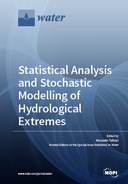Explore

Statistical Analysis and Stochastic Modelling of Hydrological Extremes
Hossein Tabari
2019
0 Ungluers have
Faved this Work
Login to Fave
Hydrological extremes have become a major concern because of their devastating consequences and their increased risk as a result of climate change and the growing concentration of people and infrastructure in high-risk zones. The analysis of hydrological extremes is challenging due to their rarity and small sample size, and the interconnections between different types of extremes and becomes further complicated by the untrustworthy representation of meso-scale processes involved in extreme events by coarse spatial and temporal scale models as well as biased or missing observations due to technical difficulties during extreme conditions. The complexity of analyzing hydrological extremes calls for robust statistical methods for the treatment of such events. This Special Issue is motivated by the need to apply and develop innovative stochastic and statistical approaches to analyze hydrological extremes under current and future climate conditions. The papers of this Special Issue focus on six topics associated with hydrological extremes: Historical changes in hydrological extremes; Projected changes in hydrological extremes; Downscaling of hydrological extremes; Early warning and forecasting systems for drought and flood; Interconnections of hydrological extremes; Applicability of satellite data for hydrological studies.
This book is included in DOAB.
Why read this book? Have your say.
You must be logged in to comment.
Rights Information
Are you the author or publisher of this work? If so, you can claim it as yours by registering as an Unglue.it rights holder.Downloads
This work has been downloaded 261 times via unglue.it ebook links.
- 203 - pdf (CC BY-NC-ND) at Unglue.it.
Keywords
- ANN model
- APCC Multi-Model Ensemble
- artificial neural network
- clausius-clapeyron scaling
- Climate Change
- climate variability
- compound events
- discrete wavelet
- downscaling
- drought analysis
- drought indices
- drought prediction
- ENSO
- evolutionary strategy
- extreme events
- extreme precipitation exposure
- extreme rainfall
- extreme rainfall analysis
- Extreme Value Theory
- Fiji
- flood management
- flood regime
- flow regime
- Forecasting
- Global warming
- HBV model
- heavy storm
- high resolution
- Hurst exponent
- hydrological drought
- hydrological extremes
- hyetograph
- INDC pledge
- innovative methods
- Kabul river basin
- least square support vector regression
- Machine learning
- meteorological drought
- monsoon
- multivariate modeling
- non-normality
- non-stationary
- Pakistan
- polynomial normal transform
- precipitation
- Rainfall
- random forest
- Reservoir inflow forecasting
- sampling errors
- satellite data
- seasonal climate forecast
- SIAP
- simulation
- sparse monitoring network
- statistical analysis
- statistical downscaling
- Streamflow
- stretched Gaussian distribution
- support vector machine
- SWSI
- temperature
- the Cauca River
- Trends
- TRMM
- uncertainty
- variation analogue
- wavelet artificial neural network
- weighted mean analogue
Links
DOI: 10.3390/books978-3-03921-665-9Editions


